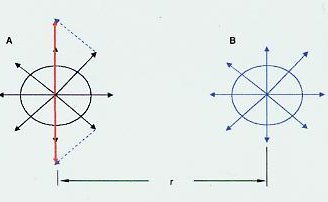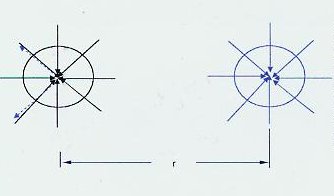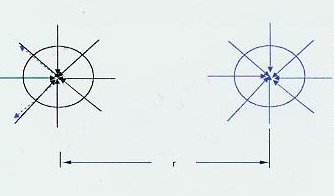Electromagnetic Vector Process
Attraction and repulsion of electromagnetic matter emissions from mass objects in space is an explanation of the phenomenon heretofore known as gravity. Such a concept is plausible because mass objects emit matter, because of the equality of mass and energy, and because force is an artificial concept based upon the inconsistent and artificial concept of time. However, mass and three dimensional space are known to exist, and are basic quantities in the scientific study of the universe. Vector operations on emitted matter directed in three-dimensional space are simple and straight-forward concepts. Herein, it is proposed that the phenomenon called gravity is nothing more than the mutual nullification of opposing emission streams of matter from mass objects in space, such as solar pulses or solar flares associated with geomagnetic storms. In this sense, gravity can be said to be absolutely nothing.

A & B TRANSMITTING:
Vector addition, see illustration to left, of B emission with corresponding A emission results in use of B emission to redirect A emission laterally from between A & B, thereby unbalancing net thrust from accumulated emissions. Emissions from relative proximal sides of A & B result in net thrust imbalance inducing displacement of A toward B and B toward A. Accompanying reduction in separation of centers, r, invites continuation of displacement process to greater extent. This is consistent with observed phenomenon known as gravitation and the concept of acceleration.

A & B RECEIVING:
Vector addition, see illustration to left, of B reception with corresponding A
reception results in use of B reception to nullify A reception laterally
from between A & B, thereby unbalancing net thrust from accumulated
reception. Reception from relative proximal sides of A & B result in net
thrust imbalance inducing displacement of A toward B and B toward A.
Accompanying reduction in separation of centers, r, invites continuation of
displacement process to greater extent.

A TRANSMITTING & B RECEIVING:
Vector addition, see illustration to left, of B reception with corresponding A emission results in use of B reception to fortify A emission between A & B, thereby unbalancing net thrust from accumulated emissions and reception. Emissions from and reception by relative proximal side of A & B, respectively, result in net thrust imbalance inducing displacement of A away from B and B away from A. Accompanying increase in separation of centers, r, invites continuation of displacement process to lesser extent.
Insight
Ask the question, "What makes an object drop to the ground?" The most common answer is, "Gravity!" But then, ask the question, "Why does a helium-filled balloon rise?" The most common answers are, "It's lighter than air.", or more correctly, "It's less dense than its surroundings." Ask the first question again, "What makes an object drop to the ground?" The answer usually changes to. "It's denser than its surroundings."
Density is mass per unit volume, as pounds per cubic foot. The force of gravity is expressed two ways. First, according to Galileo, it is a function of the product of the interacting masses per the square of the distance between the centers of the interacting masses [ G ~ (M)(m)/r2 ] Second, the force of gravity, according to Newton, is the product of a mass and it's acceleration [ G = (m)(a) ] It's interesting that Galileo saw the force of gravity as dependent on the amount of mass and separation only, ignoring any involvement of acceleration [a = d/t2 as feet/second/second. Neither Galileo nor Newton included density in the concept of gravity. They did not address the distinctions which are apparent in the questioning and responses described above. Involving the concept of density, by including volume into the theory, we intuitively believe the following:
-
If the volume is large enough, the object will rise (as dandelion seeds, blimps, corks in water)
-
If the volume is small enough, the object will fall (as stones, blimps with big holes, corks in air)
-
If the volume is just right, the object is suspended in its surroundings (as stones in sand, partly filled bottles in water)
Buoyancy, as discovered by Archimedes, adds more complexity to the concept of gravity as an inherent property of mass. No wonder scientists can't find the gravitational force!
